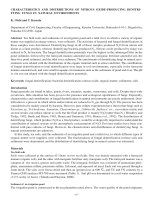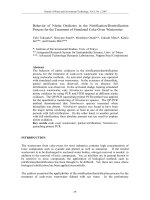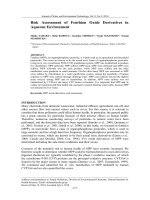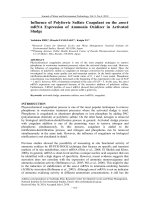(Oxford american handbooks of medicine) andrew blitzer, jerome schwartz, phillip song, nwanmegha young oxford american handbook of otolaryngology oxford university press (2008)
Bạn đang xem bản rút gọn của tài liệu. Xem và tải ngay bản đầy đủ của tài liệu tại đây (3.85 MB, 461 trang )
ERROR! NO TEXT OF SPECIFIED STYLE IN DOCUMENT.
OXFORD MEDICAL PUBLICATIONS
Oxford American Handbook of
Otolaryngology
i
ii
Published and forthcoming Oxford American Handbooks
Oxford American Handbook of Anesthesiology
Oxford American Handbook of Clinical Dentistry
Oxford American Handbook of Clinical Medicine
Oxford American Handbook of Surgery
Oxford American Handbook of Critical Care
Oxford American Handbook of Emergency Medicine
Oxford American Handbook of Otolaryngology
Oxford American Handbook of Nephrology and Hypertension
Oxford American Handbook of Obstetrics and Gynecology
Oxford American Handbook of Pediatrics
Oxford American Handbook of Psychiatry
Oxford American Handbook of Pulmonary Medicine
iv
Oxford University Press, Inc., publishes works that further
Oxford University’s objective of excellence
in research, scholarship, and education.
Oxford New York
Auckland Cape Town Dar es Salaam Hong Kong Karachi
Kuala Lumpur Madrid Melbourne Mexico City Nairobi
New Delhi Shanghai Taipei Toronto
With offices in
Argentina Austria Brazil Chile Czech Republic France Greece
Guatemala Hungary Italy Japan Poland Portugal Singapore
South Korea Switzerland Thailand Turkey Ukraine Vietnam
Copyright © 2008 by Oxford University Press, Inc.
Published by Oxford University Press, Inc.
198 Madison Avenue, New York, New York 10016
www.oup.com
Oxford is a registered trademark of Oxford University Press
All rights reserved. No part of this publication may be reproduced,
stored in a retrieval system, or transmitted, in any form or by any means,
electronic, mechanical, photocopying, recording, or otherwise,
without the prior permission of Oxford University Press.
Library of Congress Cataloging-in-Publication Data
Oxford American handbook of otolaryngology/Andrew Blitzer ... [et al.].
p. ; cm. — (Oxford American handbooks)
Based on: Oxford handbook of ENT and head and neck surgery/Rogan
Corbridge and Nicholas Steventon. 2006.
Includes bibliographical references and index.
ISBN 978-0-19-534337-3
1. Otolaryngology—Handbooks, manuals, etc.
2. Head—Surgery—Handbooks, manuals, etc. 3. Neck—Surgery—Handbooks,
manuals, etc. I. Blitzer, Andrew. II. Corbridge, Rogan J. Oxford
handbook of ENT and head and neck surgery. III. Title: Handbook of
otolaryngology. IV. Series.
[DNLM: 1. Otorhinolaryngologic Diseases—Handbooks.
2. Head—surgery—Handbooks. 3. Neck—surgery—Handbooks.
4. Otorhinolaryngologic Surgical Procedures—Handbooks. WV 39 O98 2008]
RF56.O94 2008
617.5’1—dc22 2007044670
9 8 7 6 5 4 3 2 1
Printed in China
on acid-free paper
v
Oxford University Press makes no representation, express or implied, that the drug
dosages in this book are correct. Readers must therefore always check the product
information and clinical procedures with the most up-to-date published product
information and data sheets provided by the manufacturers and the most recent
codes of conduct and safety regulations. The authors and the publishers do not
accept responsibility or legal liability for any errors in the text or for the misuse or
misapplication of material in this work.
This page intentionally left blank
vii
Preface
This book is intended for the medical student, physician-in-training, or
Otolaryngology resident, or as a quick reference for the practitioner of
Otolaryngology. This volume is not meant to be encyclopedic, since the
breadth of Otolaryngology knowledge is so large.
Instead, it is meant to be a pocket book that can be an easy reference
for the student or practitioner. It covers common otolaryngologic disorders and is organized by anatomic site, disease entity, presentation, or
procedure. Current references are included for further reading and more
in-depth information. It is hoped that physicians and surgeons at all levels
will find this book valuable.
The authors would like to thank Kevin Kochanski, William Lamsback, and
Nancy Wolitzer, our developmental editors at Oxford University Press, for
all of their assistance in organizing this volume, and David Cognetti and
Berrylin Ferguson for their help in editing the manuscript. In addition,
we are indebted to Myung Song of Woodstock, New York, for her medical
illustrations in Chapter 16, on facial plastic surgery and reconstruction.
This page intentionally left blank
ix
Contents
Preface vii
Detailed contents xi
1
2
3
4
5
6
7
8
9
10
11
12
13
14
15
16
17
18
19
Overview
The ENT examination
Common methods of presentation
Investigations in ENT
The mouth, tonsils, and adenoids
The nose and sinuses
The salivary glands
The larynx
The esophagus
The neck
The thyroid and parathyroid glands
The external ear
The middle ear
The inner ear
The skull base
Facial plastic surgery and reconstruction
Common operations
Ward care
Practical procedures
1
11
41
67
85
109
143
161
191
203
219
233
253
275
309
327
359
375
389
20 ENT emergencies
409
21 Glossary of ENT terms and eponyms
425
Index 435
This page intentionally left blank
xi
Detailed contents
1
Overview
Using this book 2
1
Otolaryngology as a subject and career 3
Students and Otolaryngology 4
ENT learning aims and objectives for clinical
medical students 5
Student Otolaryngology curriculum 6
Research 8
Critical appraisal of the literature 9
2
The ENT examination
Equipment 12
11
Examination of the ear 14
Examination of the nose 22
Rigid nasal endoscopy 24
Examination of the mouth, larynx, and pharynx 26
Flexible laryngoscopy 28
Stroboscopy 30
Examination of the neck 32
Cranial nerve examination 34
3
Common methods of presentation
Hoarse voice 42
Epistaxis (nosebleed) 44
Dysphagia (swallowing difficulty) 46
Globus (a feeling of a lump in the throat) 48
Neck mass 50
Mouth or tongue ulcer 52
41
xii
DETAILED CONTENTS
Stridor 54
Facial nerve palsy 56
Nasal obstruction 57
Otorrhea 58
Dizziness and vertigo 59
Otalgia (earache) 60
Hearing loss 62
Tinnitus 64
Facial pain 65
4
Investigations in ENT
Hearing physiology 68
67
Pure tone audiometry (PTA) 70
Speech audiometry 72
Tympanometry 74
Objective hearing assessment 76
Pediatric hearing assessment 77
Electronystagmography (ENG) 78
Calorics 79
CT scan 80
MRI scan 81
PET scan 82
Skin prick testing 83
5
The mouth, tonsils, and adenoids
Anatomy 86
Oral ulcers—benign 88
Oral ulcers—malignant 90
White patches in the mouth 92
Miscellaneous mouth conditions 94
Pharyngitis 96
Tonsillitis 98
85
DETAILED CONTENTS
Infectious mononucleosis 99
Tonsillectomy 100
Tonsillar tumors 102
Adenoidal enlargement 104
Obstructive sleep apnea 106
6
The nose and sinuses
Structure and function of the nose 110
109
Rhinitis 116
Medical treatment of rhinitis 118
Surgical treatment of nasal obstruction 120
Olfaction 121
Sinusitis 122
Acute sinusitis 123
Recurrent acute sinusitis 124
Chronic sinusitis 125
Pediatric sinusitis 126
Complications of sinusitis 128
Fungal sinusitis 131
Nasal polyps 132
Unusual nasal polyps 134
Septal problems 136
Septal perforation 137
Granulomatous conditions 138
Sinonasal masses 140
Allergy and immunotherapy 141
7
The salivary glands
Structure and function of the salivary glands 144
Disorders of salivation 147
Salivary gland tumors 148
Sialadenitis 152
143
xiii
xiv
DETAILED CONTENTS
Sialolithiasis 153
Other inflammatory conditions 154
Pseudosalivary swellings 156
Salivary gland surgery 158
8
The larynx
Structure and function of the larynx 162
161
The vocal cords 166
Congenital laryngeal lesions 168
Infections of the larynx 170
Cancer of the larynx 174
Treatment of laryngeal cancer 176
Benign lesions of the larynx 180
Stridor 185
The emergency airway 186
Tracheostomy care and tracheostomy tubes 188
9
The esophagus
Introduction 192
191
Globus 193
Laryngopharyngeal reflux 194
Neurological causes of swallowing problems 195
Post-cricoid web 196
Achalasia 197
Zenker’s diverticulum 198
Esophageal tumors 200
Barrett’s esophagus 202
10
The neck
Anatomy of the neck 204
Investigation of neck masses 208
Congenital neck remnants 210
203
DETAILED CONTENTS
Neck infections 214
Lymph node enlargement 215
Neoplastic lymphadenopathy 216
Neck hernias 218
11
The thyroid and parathyroid glands
Embryology and anatomy of the thyroid 220
219
Thyroid enlargement (goiter) 222
Thyroid neoplasia 224
Thyroid investigations 226
Treatment of thyroid conditions 228
Risks and complications of thyroid surgery 229
Parathyroid embryology and function 230
Hyperparathyroidism 231
12
The external ear
Structure and function 234
233
Congenital abnormalities 236
Infection of the pinna 238
Trauma to the pinna 240
Otitis externa 242
Necrotizing otitis externa 244
Malignancy of the pinna 246
Malignancy of the external auditory canal 248
Miscellaneous conditions 250
13
The middle ear
Structure and function 254
Congenital abnormalities 257
Acute otitis media 258
Complications of acute otitis media 260
Glue ear 261
253
xv
xvi
DETAILED CONTENTS
Chronic suppurative otitis media without
cholesteatoma 262
Chronic suppurative otitis media with
cholesteatoma 264
Mastoid surgery 266
Complications of chronic suppurative
otitis media 268
Otosclerosis 270
Trauma 272
Neoplasia 273
14
The inner ear
Structure and function of the inner ear 276
275
Sensorineural hearing loss (SNHL) 280
Presbyacusis 282
Noise-induced hearing loss 284
Idiopathic sudden hearing loss 286
Tinnitus 288
Autoimmune ear disease 290
Ototoxicity 292
Hereditary hearing loss 294
Syndromic hearing loss 296
Syndromic hearing loss II 298
Nonorganic hearing loss (NOHL) 299
Labyrinthitis (vestibular neuronitis) 300
Benign paroxysmal positional vertigo 302
Meniere’s disease/syndrome 304
Treatment of Meniere’s disease 306
Vascular causes of inner ear dysfunction 308
15
The skull base
Overview 310
Anatomic considerations 312
309
DETAILED CONTENTS
Acoustic neuroma 314
Glomus jugulare tumors 316
Nasopharyngeal carcinoma (NPC) 318
Juvenile angiofibroma 320
Sinonasal malignancy 322
Temporal bone fractures 324
Complications of surgery 326
16
Facial plastic surgery and reconstruction
Principles of reconstruction 328
327
Wound healing 329
Scar revision 330
Common local and regional flaps 332
Pedicled flaps 336
Free flaps 338
Principles of aesthetic examination 342
Rhytidectomy 352
Skin resurfacing 354
Botulinum toxin injections 356
17
Common operations
Obtaining informed consent 360
Presenting information to patients 361
Establishing capacity to make decisions 362
Tonsillectomy 364
Adenoidectomy 366
Tympanostomy tube insertion 367
Tympanoplasty 368
Septoplasty and turbinate reduction 370
Direct laryngoscopy 371
Complications of ear surgery 372
359
xvii
xviii
DETAILED CONTENTS
Complications of nasal surgery 373
Complications of head and neck surgery 374
18
Ward care
Preoperative care 376
375
Special considerations 378
Postoperative care 380
Care of reconstructive flaps 384
Tracheostomy care 386
Communication with patients and relatives 387
Discharge planning 388
19
Practical procedures
How to cauterize the nose 390
389
How to pack the nose 392
How to remove foreign bodies 394
How to irrigate an ear 398
How to dry a draining ear 400
How to instill eardrops 402
How to drain a hematoma of the auricle 404
How to drain a peritonsillar abscess 406
How to perform fine needle aspiration
cytology (FNAC) 408
20
ENT emergencies
Epistaxis 410
Sudden-onset hearing loss 412
Facial palsy or VII nerve palsy 414
Periorbital cellulitis 417
Fractured nose 418
Penetrating neck injury 420
Esophageal foreign bodies 422
409
DETAILED CONTENTS
Caustic ingestion 423
Secondary tonsillar hemorrhage 424
21
Glossary of ENT terms and eponyms
Index 435
425
xix
This page intentionally left blank
Chapter 1
Overview
Using this book 2
Otolaryngology as a subject and career 3
Students and Otolaryngology 4
ENT learning aims and objectives for
clinical medical students 5
Student Otolaryngology curriculum 6
Research 8
Critical appraisal of the literature 9
1
2
CHAPTER 1
Overview
Using this book
The purpose of this book is to provide concise, practical guidelines associated with treating disorders of the head and neck. We wish to provide
a basic fund of knowledge of Otolaryngology, with particular emphasis on
common ear, nose, and throat (ENT) problems. The breadth of Otolaryngology practice is so wide today that an attempt to be comprehensive
would be impossible, and for the sake of brevity, many of the subtleties
of clinical practice have been excluded here. As a reference book, the
Oxford Handbook is well organized and designed to be slipped inside the
pocket of a white coat for rapid consultation. It is suitable for the ward,
rounds, and clinic. In addition, we have included reference lists at the end
of each chapter that provide a more in-depth understanding of each
disorder.
The book is organized as a primer to Otolaryngology. It begins with a
description of the head and neck examination and history taking as
related to disorders of the head and neck. Unique for this type of book is
Chapter 3, “Common methods of presentation,” which is a guide for
dealing with patients as they present with symptoms in clinical practice.
It also provides a convenient way of accessing the relevant chapter in the
anatomical list. The bulk of the handbook is organized on the basis of
anatomic sites. The last several chapters are very helpful for describing
common surgical procedures used in Otolaryngology, ENT emergencies,
and common eponyms used.
OTOLARYNGOLOGY AS A SUBJECT AND CAREER 1
Otolaryngology as a subject and career
Otolaryngology is a fantastic specialty that is every bit as exciting in
practice as it is in theory. It is difficult to conceive of any specialty that can
provide such diversity in medical practice.
- ENT conditions make up 25%–50% of all general-practice consultations.
- ENT conditions affect people of all ages, from infants to the elderly.
- Outpatient work is about 50% of the workload. This gives a good
balance between surgical and medical practice.
- The major broad divisions of Otolaryngology and head and neck
surgery include otology and neurotology, rhinology, facial plastics and
reconstructive surgery, head and neck cancer surgery, laryngology,
allergy, and pediatric Otolaryngology.
- Surgical skills are broad, from microsurgery on the smallest bones in
the body to major head and neck reconstructive surgery.
- Otolaryngology offers enormous research potential, including nasal
polyps, congenital hearing loss, immunology, and genetics of cancer.
- Cutting-edge developments are occurring in Otolaryngology, such as
cochlear implantation, auditory brainstem implantation, and laser surgery. There is a constant evolution of surgical techniques and devices.
Further sources of information
- American Academy of Otolaryngology and Head and Neck Surgery
www.entnet.org
- American Academy of Facial Plastic and Reconstructive Surgery
www.aafprs.org
- American Broncho-Esophagological Association
www.abea.net
- American Society of Pediatric Otolaryngologists
www.aspo.us
- American Laryngological Association
www.alahns.org
- The Triological Society
www.triological.org
- American Neurotology Society
www.americanneurotologysociety.com
- American Academy of Otolaryngic Allergy
www.aaoaf.org
- American Rhinologic Society
www.american-rhinologic.org
3
4
CHAPTER 1
Overview
Students and Otolaryngology
The subject of Otolaryngology can seem quite daunting to students.
This vast subject occupies a small part of the medical curriculum, and in
some instances has been dropped entirely from medical-school programs.
In strong contrast to the time given to the field in training, otolaryngological conditions make up between 25% and 50% of all generalpractice consultations. As a student, it is important to have a firm idea of
the important topics you want to cover in Otolaryngology. These will
form your learning aims and objectives—see the next section (p. 5).
There may be local variations.
Although you will find that Otolaryngology departments throughout
the world are welcoming to students, do not abuse their hospitality by
being late or discourteous. Professional conduct is important, whatever
the specialty you are studying.
There are particularly sensitive areas within Otolaryngology practice
that require special tact as a student. Two of these are head and neck
cancer and hearing problems.
Head and neck cancer
These cancers form an important part of the Otolaryngology workload.
You will need to be sensitive in dealing with these patients. They often have
unique problems associated with their disease and treatment including the
following:
- Poor communication
- Disfiguring surgery
- Depression
- Alcohol withdrawal
Hearing problems
The diagnosis of hearing loss in a child can be a devastating blow to
parents. You will need to be sensitive to this. Another cause of great
concern to parents is when a poorly performing child has a normal hearing
test, as this may confirm the diagnosis of global developmental delay.
ENT learning aims and objectives
ENT LEARNING AIMS AND OBJECTIVES 1
ENT learning aims and objectives for
clinical medical students
Aims
- To acquire sufficient knowledge of ENT conditions to be able to
recognize common problems and when and what to refer
- To understand that ENT conditions are extremely common and form
a large part of the workload of a general practitioner
- To learn the skills required to examine patients with ENT diseases and
to make a presumptive diagnosis
- To learn how to prioritize and manage different ENT conditions
- To become stimulated by and interested in the specialty of
Otolaryngology
Objectives
- To learn the signs and symptoms of common ENT conditions
- To learn the techniques of ear, nasal, and neck examination
- To demonstrate an understanding of the basic anatomy and physiology
of the ear and upper aerodigestive tract, and relate this knowledge to
the signs and symptoms of ENT disease
- To understand the medical and surgical treatment of common
ENT conditions
- To be familiar with the commonly used medications for treating
ENT problems, and their side effects
- To understand the risks and complications of surgery
- To recognize the different ways in which head and neck malignancy
can present, and to understand that early diagnosis of head and neck
cancer leads to improved survival
- To learn the ways in which ENT-related communication difficulties can
arise and be overcome
- To appreciate and be sensitive to the impact of ENT conditions on
patients and their families
5









